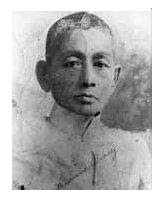Top. Execution of La Liga Filipina members
Execution of captured Katipuneros

Above. The first Katipuna casualties of the 1896 revolution.
Above. The arrival of Spanish reinforcements in 1896, a big event during that time based on the amount of coverage it got from the local press.
Above. Spanish soldiers out on the field
Above. A Spanish soldier in the Philippines and a Filipino auxillary in Spanish service.
Both soldiers seem to be equipped with the The Spanish 7x57 mm Mauser, Model 1893, sometimes incorrectly referred to as Remingtons.
A number of Filipino auxillaries were members of the Katipunan, which led to several defections to the Katipunan side. Gen. Santiago Alvarez in his memoirs recount that in the early hours of August 30, 1896, after several successful skirmishes against the civil guards, Andres Bonifacio received several defectors in Cubao together with their rifles prior to attacking the Spanish polvorin in Sta. Mesa. In some cases, during firefights, some of the Filipino auxilliaries aimed high or low, so as not to hit the Katipuneros. One can also note that during Rizal's execution, there is a second line of Spanish soldiers, behind the auxilliaries to finish the job just in case.
Spanish response to the discovery of the Katipunan was swift and brutal.
Spanish troops in the Territorial Division of the Philippines in May 1898, when the war between the U.S. and Spain erupted, were commanded by General Fermin Jaudenes y Alvarez, and consisted of seven regiments of native infantry, 15 expeditionary battalions organized in Spain and sent to the islands to assist in the suppression of the insurrection; one native cavalry regiment; one expeditionary cavalry squadron; one regiment of fortress artillery; one regiment of mountain artillery; a regiment of native engineers; one company of Marine Infantry; a single ordnance detachment; three tercia, or regiments, of native Civil Guard; one detachment of native Carabineros, or custom guards; a native train, or transport, unit; a sanitary detachment, plus at least 12 companies of militia and guerrillas.
Spanish colonial troops had worn a lightweight uniform of linen, or lienzo, since the 1770s. This became their multi-purpose uniform in Cuba when the full dress uniform was abolished on June 3, 1876, subsequent to the Royal Decree of June 11, 1874. This law appears to have been extended to the garrison on Puerto Rico via the Royal Order of October 8, 1880. On November 11, 1892, the same style of campaign uniform as described in the Decrees of 1876 and 1880 were extended to the troops in the Philippines.
Below is the Spanish Orbat as of October 1897.
Spanish Order of Battle (1897) Below is the Spanish Orbat as of October 1897.
source: http://www.spanamwar.com/spoobphil.htm
Native Regiment # 68 (Legaspi). 2 Battalions.
(Headquartered in Jolo; in the field in Luzon and Mindanao, with detachments in Carolina and Paragua Islands)
Native Regiment # 69 (Iberia). 2 Battalions.
(Headquartered in Zamboanga; in the field in Luzon)
Native Regiment # 70 (Magallanes). 1 Battalion.
(Headquartered in Manila; in the field in Luzon)
Native Regiment t#71 (Mindanao). 2 Battalions.
(Headquartered in Iligan; at Manila, and in the field in Mindanao)
Native Regiment #72 (Visayas). 1 Battalion.
(Headquartered in Manila; and in the field in Mindanao)
Native Regiment #73 (Jolo). 2 Battalions.
(Headquartered in Manila; in the field in Luzon and Mindanao)
Native Regiment t#74 ((Manila). 2 Battalions.
(Headquartered in Manila; in the field in Luzon and Mindanao)
Probable Total, Native Regiments: 372 Spanish, 11,368 native1
Expeditionary Battalions (Battalones cazadores expedicionarios)
#1 thru #15, from Spain, (461 officers, 20,149 men)5 consisting of:
1st Expeditionary Rifle Battalion (Military District of Luzon)2nd Expeditionary Rifle Battalion (Military District of Luzon)3rd Expeditionary Rifle Battalion (Military District of Luzon)4th Expeditionary Rifle Battalion (Military District of Luzon)5th Expeditionary Rifle Battalion (Military District of Luzon)6th Expeditionary Rifle Battalion (Military District of Luzon)7th Expeditionary Rifle Battalion (Military District of Luzon)8th Expeditionary Rifle Battalion (Military District of Luzon)9th Expeditionary Rifle Battalion (Military District of Luzon)10th Expeditionary Rifle Battalion (Military District of Luzon)11th Expeditionary Rifle Battalion (Military District of Luzon)12th Expeditionary Rifle Battalion (Military District of Luzon)13th Expeditionary Rifle Battalion (Military District of Luzon)14th Expeditionary Rifle Battalion (Military District of Luzon)15th Expeditionary Rifle Battalion (Military District of Luzon)
1st Regiment of Marine Infantry (45 officers, 1,743 men)
Cavalry (Caballeria de Filipinas) Regiment #31 (31 officers, 161 Spanish troopers, 453 native troopers)
Cavalry Squadron (Lanceros Expedicionario, No.1) (11 officers, 162 Spanish troopers)
Regiment de la Plaza (fortress artillery) (40 officers, 1,500 men)
6th Regiment of Artillery (mountain artillery) (21 officers, 696 men)
Battalion of Engineers (31 Spanish officers, 1,266 natives)
One Battalion Carabineros (volunteer riflemen, listed in some sources as Customs Guards)(14 Spanish officers, 415 natives)
Guardia Civil Regiments (three regiments)(155 Spanish officers, 3,530 natives)6
Guardia Civil Regiment #20Guardia Civil Regiment #21Guardia Civil Regiment #22
One Transport Brigade (Unknown; probably 15 Spanish officers and innumerable native drivers)
One Sanitary Detachment (4 officers, 345 Spaniards)
One Ordnance Detachment (Maestranza) (4 officers, 72 Spaniards)
Probable Total, Spanish Forces: 25,660 Spanish, 5,664 natives2






















































